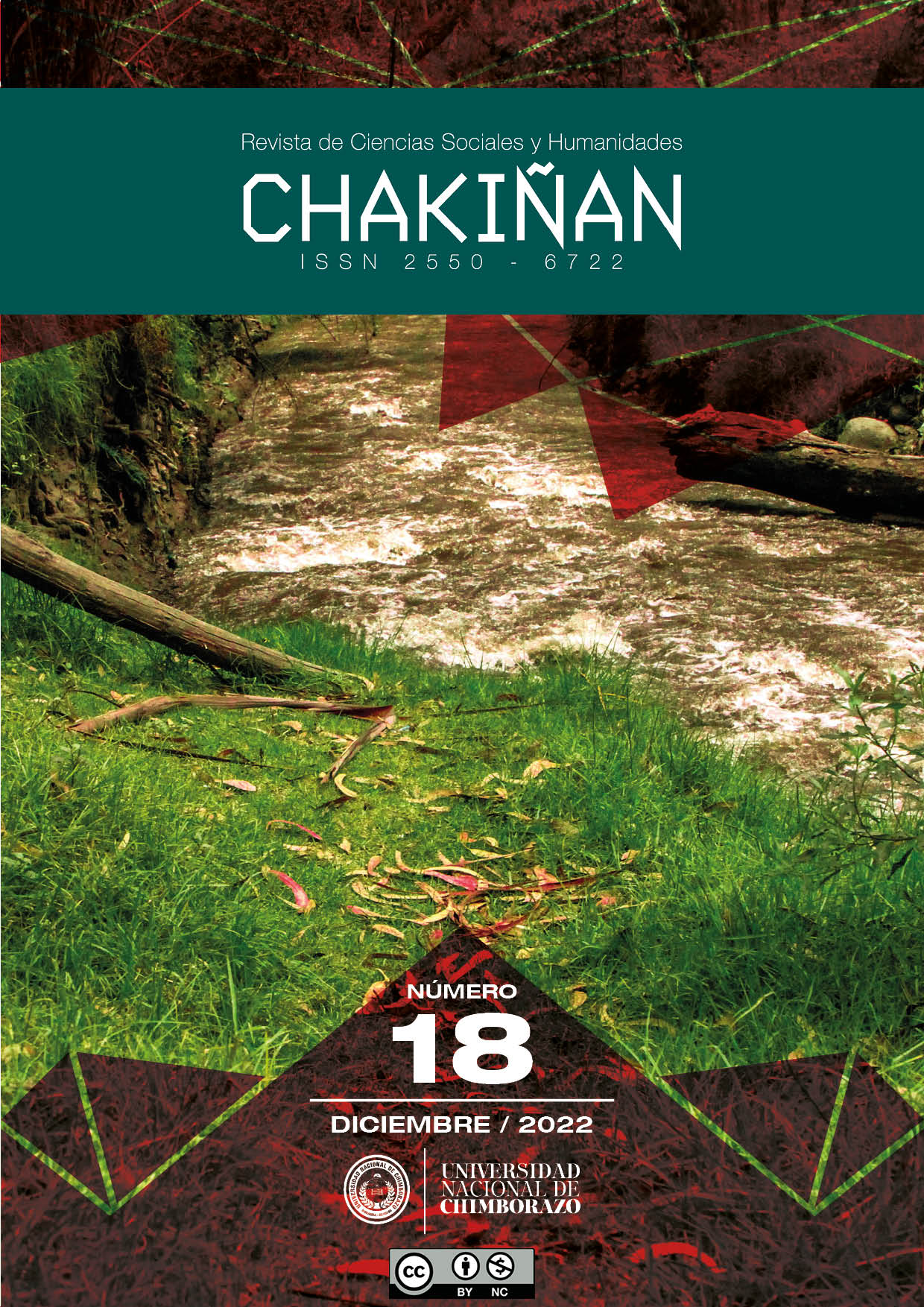THE SHAMANIC PRACTICES OF THE CHACHI PEOPLE IN THE NORTH OF ESMERALDAS, ECUADOR
Main Article Content
Abstract
It starts from the conception of shamanism as a set of traditional beliefs and practices that ensure the ability to cure diseases and generate human suffering. For this reason, shamanic practices constitute an essential part of indigenous peoples, presenting a range of dimensions that structure the way of seeing and understanding the world, from the recognition of the existence of spiritual beings to the belief in spirits that grant power to the shamans to do good and evil. This article aimed to describe the shamanic practices of the Chachi people of northern Esmeraldas and identify the relationships between envy and witchcraft. A qualitative approach was used with an ethnographic research design and an explanatory analysis based on the interlocutors' accounts. The results showed that the Chachi population performs shamanic practices with two goals: improving health and doing evil.
Downloads
Article Details
Conference Proceedings Volume
Section

This work is licensed under a Creative Commons Attribution-NonCommercial 4.0 International License.
Responsibility of the authors:
The authors are responsible for the ideas and data collected in the manuscripts. They are additionally accountable for the fidelity of the information, the correction of the citations, the right to publish any material included in the text, and the presentation of the manuscript in the format required by the Journal (WORD template). A manuscript forwarded to CHAKIÑAN must not have been published before, nor must it have been submitted to another means of publication.
Copyright:
Published articles do not necessarily compromise the viewpoint of the CHAKIÑAN JOURNAL. The Journal is aligned to the policy of the licence de Creative Commons Reconocimiento-No comercial 4.0 Internacional (CC BY-NC 4.0). Each author retains the right to the paper published in the Chakiñan journal.
Privacy statement
The personal data and email addresses entered in this magazine will be used exclusively for the purposes stated by the publication and will not be available for any other purpose or person.
How to Cite
Share
References
Acuña, A. (2016). Del chamanismo y la festividad social al futbol yanomami: una nueva manera de compartir y competir. Nueva antropología, 27(80), 111-137. http://www.scielo.org.mx/scielo.php?script=sci_arttext&pid=S0185-06362014000100006&lang=es
Añapa, J. (2003). Chachi. Lala’cha’kuinda, Naa Na Chumua Juhua Ju’bain, Naa Chaibain. Quito, Ecuador: Indio-Hilfe.
Añapa, J. y Estupiñán, L. (2016). Miruku Chachi. El hombre sabio de la nacionalidad Chachi. (Tesis de pregrado). Universidad de Cuenca, Cuenca, Ecuador. http://dspace.ucuenca.edu.ec/handle/123456789/20157?locale=es
Barrett, S. (1994). Los indios cayapas del Ecuador. Quito, Ecuador: Abya-Yala.
Basurco, S. (1982). Viaje a la región de los cayapas. Madrid, España: Comercio.
Carrasco, E. (1983). El pueblo Chachi: El jeengume avanza. Quito, Ecuador: Abya-Yala.
Contreras, I. (2020). No-humanos, tiempos-espacios y socialidad amazónica entre los llanchama runa del río Tiputini. Anthropologica, 38(45), 1-28. http://www.scielo.org.pe/scielo.php?script=sci_arttext&pid=S0254-92122020000200085&lang=es
De la Cadena, M. (2019). Cosmopolítica indígena en los Andes: Reflexiones conceptuales más allá de la política. Tabula Rasa, 10(33), 273-311. https://www.revistatabularasa.org/numero33/cosmopolitica-indigena-en-los-andes-reflexiones-conceptuales-mas-alla-de-la-politica/
Descola, P. (2005). Más allá de la naturaleza y cultura. Buenos Aires, Argentina: Gallimard.
Estupiñán, J. (1980). Historia de Esmeraldas: Monografía Integral. Santo Domingo, Ecuador: Gregorio.
Fagetti, A. (2010). Ixtlamatki versus nahualli. Chamanismo, nahualismo y brujería en la Sierra Negra de Puebla. Revista pueblos y fronteras, 5(10), 4-23. http://www.scielo.org.mx/scielo.php?script=sci_arttext&pid=S1870-41152010000200004&lang=es
Fericgla, J. (1998). El chamanismo a revisión: De las vías extáticas de curación y adaptación al internet. Quito: Abya-Yala. https://digitalrepository.unm.edu/abya_yala/178/
García, S. (2016). Mujeres Mapuche, extractivismo y Kume Felen (Buen vivir): La lucha por los bienes comunes en Neuquén. Millcayac: Revista Digital de Ciencias Sociales, 3(4), 15-40. https://dialnet.unirioja.es/servlet/articulo?codigo=5665446
Geertz, C. (1992). La interpretación de las culturas. Barcelona, España: Gedisa.
Guhl, J. (2020). Un accidente de tránsito visto a través de los ojos del chamanismo amazónico. Anthropologica, 38(44), 1-27. http://www.scielo.org.pe/scielo.php?script=sci_arttext&pid=S0254-92122020000100013&lang=es
Lavazza, H. (2016). Más allá de la naturaleza y la cultura. Apuntes CECYP, 27(18), 233-239. https://publicaciones.sociales.uba.ar/index.php/apuntescecyp/article/view/4619
Malinowski, B. (1973). Los Argonautas del pacífico occidental. Barcelona, España: Planeta.
Medina, H. (1997). Los Chachis de Esmeraldas. Quito, Ecuador: Abya-Yala.
Ochoa, J. (2002). Mito y chamanismo: El mito de la tierra sin mal en los Tupí- Cocoma de la Amazonía peruana (Tesis doctoral). Universidad de Barcelona, Barcelona, España. http://diposit.ub.edu/dspace/handle/2445/35632
Rodríguez, J. y Lincoleo, J. (2016). Discusión sobre la presencia de la brujería europea y del chamanismo Mapuche en un relato de Martha Brunet. Acta literaria, 15(53), 127-153. http://www.scielo.org.mx/scielo.php?script=sci_arttext&pid=S1870-41152010000200004&lang=es
Turner, V. (1969). El proceso ritual. Nueva York, EEUU: Taurus.
Wolf, T. (1879). Memoria sobre la geografía y geología de la provincia de Esmeraldas. Guayaquil, Ecuador: El Comercio.
Yépez, J. (2011). El Sentido Plural: Relaciones entre los pueblos Chachi y Negro del norte de Esmeraldas. Quito, Ecuador: Abya-Yala.






